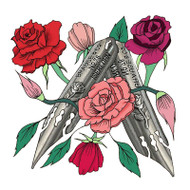
Brause Rose Nib
Posted by Sarah @ PIA on Feb 16th 2023
The beautiful Rose nib is manufactured by Brause, a German company founded in 1850 by Carl Bergfeld and brothers Friedrich, Wilhelm and Carl Brause. Brause has produced some of the highest quality supplies for calligraphers throughout their history, and continues to today.
The Rose is modeled on a vintage nib design and features a lovely embossed rose on the body. However, this pointed pen is more than just a pretty face; with the perfect balance of strong and flexible, the Rose gathers rave reviews from our customers. However, this nib can be difficult to grasp, especially if you're a beginner calligrapher who's used to stiff G nibs like Nikko or Tachikawa. We're to help you master the Rose, which will soon become one of your favorite calligraphy nibs.
Left: @thepostmansknock with Bleedproof White Right: @happyhandsproj with Ziller Ink
First, let's cover the calligraphic styles this nib is best for. If you're a die-hard Spencerian devotee, the Rose is not your friend. This nib is incredibly flexible, and its name to fame is the dramatic, juicy swells it produces. Stiffer, fine-point nibs that allow more control over pressure are better for Spencerian. If you're a lifelong Copperplate/Engrosser's fan, the Rose is suitable, but still not the best choice. This nib is best for modern calligraphy styles that focus more on drama, fun, boldness, and bouncy letters, not delicate hands that emphasize creating the finest possible hairlines.
@amandascalligraphy on Rhodia paper
The Rose nib can be finicky, and one of the most notorious issues calligraphers have is getting the nib to start. The first step you should take before using any nib, not just the Rose, is to prepare the nib for calligraphy by cleaning off oil that coats its surface, usually applied by the manufacturer to keep nibs in good shape while they're in storage. You can use a variety of methods to prepare your nib––dishwashing detergent and a toothbrush, rubbing alcohol, your own saliva (sounds gross, but it works), or even sticking your brand new nib into a potato for ten minutes. However, even if you follow all these steps, sometimes the Rose nib still will not write.
@spaghetti_bolognese with Higgins Eternal ink
Our best advice is to dedicate a spot where you want your calligraphy to begin, orient your nib at a high angle in relationship to your paper, and add a small dot of ink. If you begin writing from this spot, your Rose should have all the encouragement it needs to finally start writing. Two other important factors to consider are paper and ink. Rose nibs work best with thin mediums, such as McCaffery's iron gall ink, Higgins Eternal, and Walnut inks. If you love acrylic inks like Ziller and Dr. Ph. Martin's, try diluting them with distilled water before use for best results. When it comes to paper, the smoother the better. Try Borden & Riley Marker Layout or Rhodia for practice, and Stonehenge or Arches Text Wove for finished work.
@winterbird with Fine Tec mica watercolors
The Rose's many quirks can be difficult to get used to, but once mastered, the dramatic contrasts between hairlines and swells are worth it. These nibs are also incredibly strong despite their high flexibility, and remain dependable throughout their long-lasting lifespan. Some calligraphers note that Rose nibs are like a fine wine––they get better with age. Your best Rose nib is most likely the one you've been writing with for weeks. With a good bit of time and lots of patience, we're certain the Rose will become one of your favorite nibs.
Left: @schreibkatze with Pelikan 4001 Ink Right: @chewcreates with FINETEC Watercolors
All artwork done with the Rose nib. You can purchase the Rose nib here.



